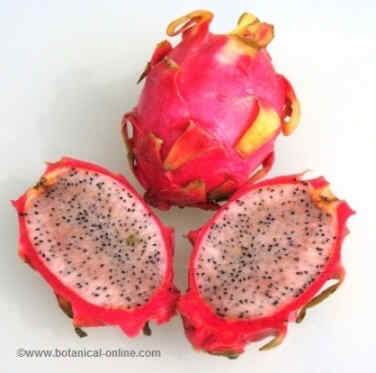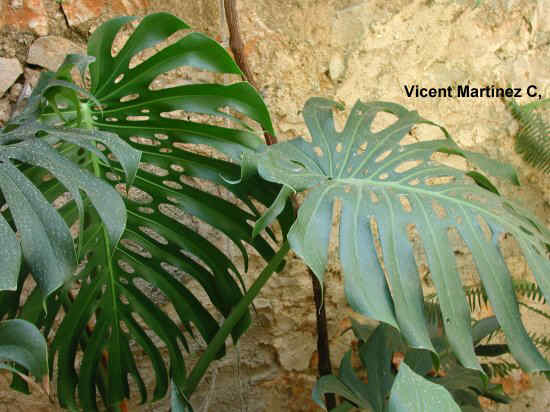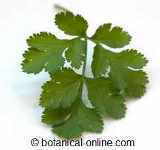Contents [show]
Properties of greater galangal
What is greater galangal and what possible benefits does it have?
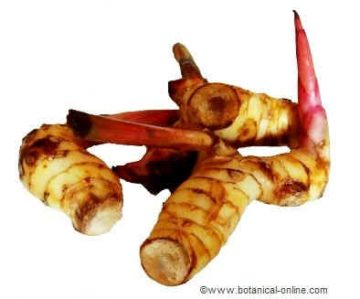
Greater galangal or blue ginger (Alpinia galanga) is a rhizomatous plant belonging to the Zingiberaceae family, such as ginger and turmeric.
In India this plant has been used for centuries for its antibiotic, anti-inflammatory, analgesic, antipyretic properties and to increase defenses.
These properties are useful mainly against respiratory infections, sore throats, stomach problems and rheumatic, muscle and joint pain.
What does greater galangal taste like?
Greater galangal is also used as an aromatic spice, like ginger and turmeric. The plant has an intense and spicy aroma, which may be reminiscent of clove. It is part of some mixes of spices such as Raz el Hanout and different masalas or curry mixes from India.
It is a common spice in Thai and Indian cuisine. In India, it is considered to have stimulating properties because, like ginger, it has a pungent, hot taste.
MEDICINAL PROPERTIES OF LA GREATER GALANGAL
Digestive properties and properties for stomach
Greater galangal is traditionally used to cure various stomach ailments such as stomach pain, Helicobacter pylori, gastritis, heartburn, and digestive ulcers.
Scientific studies have shown that this plant has anti-ulcerous properties, which protect the mucous membranes and reduce the damage caused by acidic secretions from the stomach, or to treat aphthae or mouth sores.
The stomach properties are provided by eugenol (the most abundant component in the essential oil of cloves) and the components: 1′-acetoxichavicol acetate and 1′-acetoxieugenol acetate, which are found in the rhizome and in the fruits of the plant.
Like ginger, the plant is used to treat digestive disorders such as vomiting, nausea and motion sickness.
Greater galangal for gases
Greater galangal essential oils are rich in camphor, a carminative remedy that helps eliminate gas from the digestive tract. It is used to treat intestinal gas and flatulence.
In addition, its eugenol content gives it adequate antispasmodic properties against cramps.
In short, its presence in traditional mixtures such as curry is a sample of the popular wisdom to combine foods and their properties for the digestive system.
Greater galangal for rheumatic pain and arthritis
It has been widely studied for its analgesic and anti-inflammatory effects. It is traditionally used in Ayurvedic Medicine for the treatment of rheumatic pain, muscle pain and joint pain.
There is an Ayurvedic remedy for rheumatism that is prepared from greater galangal, called Rasna.
Scientific studies have shown that a substance extracted from the rhizome, 1′-acetoxichavicol acetate, with antioxidant properties could reduce the production of cytokines, components involved in rheumatoid arthritis.
In a study of osteoarthritis patients, greater galangal supplements had an analgesic effect and improved pain.
Antibacterial properties of the greater galangal
The intense aroma and spicy flavor of the rhizome already reveals the antiseptic properties of this food. Indeed, greater galangal is a powerful antiseptic with nematocidal, antibacterial and antifungal components. It also has antiviral properties.
Greater galangal contains substances capable of fighting bacteria which cause bad breath, being a remedy for halitosis.
It has antimicrobial effects against gram-positive and gram-negative bacteria, which enables it to treat numerous bacterial skin diseases, such as acne or eczema.
The powerful antiseptic components of greater galangal are used as a remedy to help treat gastroenteritis caused by intestinal worms, diarrhea, or food poisoning.
Respiratory diseases and remedies with greater galangal
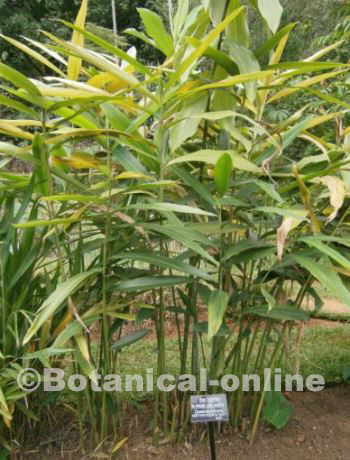
Another of the benefits of this valuable plant for Ayurveda Medicine is in its virtues for the respiratory system. Greater galangal is part of the composition of Ayurvedic medicines such as Pulmoflex®.
It is used to treat coughs, congested chest, bronchitis or bronchial colds. Because of its eugenol content, it also provides fever-reducing properties.
Like ginger, it makes you sweat which is very beneficial in the early stages of colds. It also has antiseptic components that help the body fight these infections.
Scientific studies support that greater galangal, specifically a component extracted from the rhizome (1′-acetoxichavicol acetate) can help treat asthma naturally.
Greater galangal, an immune system stimulant
Greater galangal has immunostimulatory activity, which helps to increase defenses. It is a very suitable food to help prevent colds, flu and colds, due to its action for the respiratory and anti-bacterial system.
Greater galangal to improve learning and preserve memory
It is also used as a nerve tonic and a stimulant for the nervous system. To these effects is added the reputation of stimulating food that it receives in India.
In a study carried out by the Lalitha College of Pharmacy (India), the improvement of cognitive abilities was evaluated with extracts of greater galangal. The results showed the neuroprotective role of the components of galangal, which can treat Alzheimer’s disease and help improve memory.
Greater galangal for diabetes
This plant introduced into the diet as an aromatic spice can help regulate sugar levels after eating. In an animal study, greater galangal extract lowered blood glucose levels.
This food can be especially beneficial in diets for diabetes, always accompanied by a healthy diet and adequate physical exercise.
Greater galangal dose
- Capsules: from 1 to 2 g. per dose. Up to 6g. per day.
- Infusions: 15g. of rhizome per liter or 3g. of rhizome per 200g cup.
USES OF GREATER GALANGAL EXTERNALLY
- Local analgesic: greater galangal remedies are applied externally to painful muscles and bruises for their analgesic properties. For toothache, the raw rhizome is chewed until the saliva wraps around the tooth, and spat out. It can be prepared like ginger.
- Foot fungus: due to the antifungal properties of this plant, foot baths can be used to treat feet fungus.
- For acne: great galangal contains antibacterial substances capable of fighting acne-causing bacteria. Scientific studies support the use of this natural remedy as an acne treatment.
- Herpes simplex: applied topically can help fight herpes due to the anti-herpetic properties of eugenol.
- Natural insecticide: It is a plant with a strong content of camphor and eugenol, both substances are a natural repellent against insects.
![]() More information on greater galangal
More information on greater galangal




